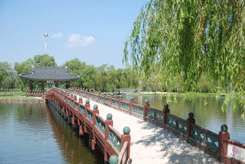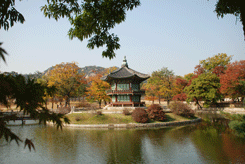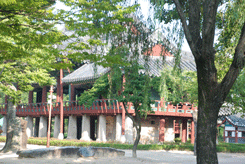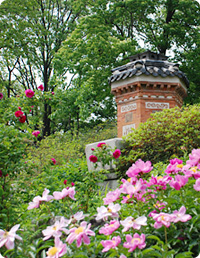Gardens
 |
 |
 |
Naturalism is a feature to the gardens of Korea. Simulating the natural landscape with a rich variety of hills, streams and fields, Korean gardens often come in small sizes but with an ideal harmony of man and the nature. Though remains of gardens built in the microcosmic style are still found in many places, those of naturalistic designs featuring trees and water are predominant as they were built in quantity from the 15th century under the strong influence of the Confucianism. Historically, the gardens of Korea have been categorized according to their function and style as follows; the sacred woods of the nature-worshiping period, the gardens of palaces and temples, the pavilion gardens of Confucian academies, the gardens of literati homes and government offices, the gardens of commoner's homes, and those of royal tombs. Out of submission to heaven's rule, no fountains that shot water heavenward were made. Instead, waterfalls and ponds to receive water from meandering waterways were favored as it was only natural to follow the law of nature by which water always flows downstream.
Sacred Woods
The genesis of the nature worship on which the idea of sacred forests rests can be found in the legend of Tangun, the founder of the Korean nation, who is said to have descended from heaven to earth under a sacred tree atop and to have built sacred city there. Such nature worship remained as late as the Joseon period as evidenced by the fact that Taejo, the founder king of Joseon honored all tutelary deities of major mountains, rivers nd ancient trees with the title of Guardian Deities of the nation. In Gyeongju, there were sacred woods called Chongyeongnim, Sinyurim and Gyerim. All the sacred woods had altars and landscaped gardens. The best known of them is Gyerim, where Kim Alji, the ancestor of Kim's clan was born here AD 67. The 7,270m² of area is densely forested with willow trees and zelkovas of more than 500 years of age among which a stream meanders.
Anapji
Records of gardens in the palaces date from the fourth century. Of the best preserved ancient palace garden is Anapji pond in Gyeongju. It was recently drained for a through excavation and restoration. Built in the garden of Donggung, the palace of the crown prince of Silla, the pond measures 15,658m². The sides of the pond are lined with dressed stones, partially forming curved or angular lines. Over the 5.2m high embankment of the pond stands recently built three pavilions along the water edge. Five other building sites were excavated, but remained unconstructed. In the middle of the pond are three small islands symbolizing the Three Gods. Twelve smaller ones are the symbolic peaks of the Musan, all alluding to the legendary Taoist locations.
Poseokjeong
It is an another Silla garden located in the southern valley of Namsan Mountain.
At the site of a detached palace in the 8th century, the pavilion is a channel in which wine cups were floated during royal feasts. The channel defies an abalone-shaped area that is 10.3m long from end to end and about 5m across the center. The garden must have been a lovely sight with thick bamboo groves, beautiful streams and dense woods of pine trees and zelkovas.
Gyeongbok palace
It is an extant Joseon palace with its beautiful gardens and pavilions. Double storied wooden Gyeongwhoeru is one of the largest pavilions built on the pond. It was used for banquets and to entertain foreign envoys. The pavilion stands on an island in a rectangular pond that is 113m long and 128m wide and is reached by three handsome stone bridges. Two small rectangular island to which there are no bridges are also in the pond. The pond was enclosed by a wall and guest could enjoy boating on it. Nearby is Amisan garden. The garden is in the back of Gyotaejon, once the royal bed chamber, features four brick chimneys adorned in beautiful patterns, stone cisterns and fantastic rocks placed among the plants on the terraced flower beds. The Jagyeongjon, the residence of the king's mother, which is located to the east of Amisan, is surrounded by the most beautiful wall in Korea, and interesting feature of which is a chimney that is hardly detectable.
The wall and the chimney are decorated with the ten longevity symbols-turtles, cranes, deer, pine, bamboo, the fungus of immortality, rocks water, clouds and the sun, as well as plants and mythical birds and animals. Hyangwonjeong, located in the northern part of the palace, is one of the most elegant palace gardens and is sits in the middle of a lotus pond. A beautiful wooden bridge spans the pond the pavilion.
Secret Garden
Behind the Changdeok palace is the Secret Garden covering 316,00m² of ground. It includes 44 buildings in different size as well as several ponds, springs, and streams. The garden was laid out in 1405 and enlarged in 1623. Throughout the year seasonal changes are mirrored in the placid ponds, while the fanciful pavilions continue to fascinate the young and the old. Buyongjeong is a graceful pavilion set by the large lotus pond, Buyongji, which is said to be fed by four springs but today these springs cannot be found. This pond has a small islet, and on the west of the pond is a small tablet constructed by Sukjong (the 19th king of the Joseon Dynasty) tells of the discovery of these four springs. Opposite the lotus pond is the Osumun gate and the Juhapru pavilion. The architectural design of this gate is impressive since the heavy roof is supported only by two small pillars. Juhapru is a double story building built by Yeongjo (the 21st king of the Joseon Dynasty). The lower floor was used as a royal library while the top floor, overlooking the spacious gardens and lotus pond spattered with colorful tints of blossoms, provided a place for entertainment and feasts. Yeonghwadang is the Lotus flower-reflecting pavilion located east of the first lotus pond upon entering the Secret Garden. It was built in 1692 and was used for public examinations for positions as government officials. On the southwestern corner of the building displays a sundial. Yeongyeongdang is the maximum size under the Joseon dynasty laws, which forbade anyone other than royalty to have a house of more than 100 Kan. Built in 1828, it is the only house in the palace in the style of a private residence, where Sunjo often frequented to experience the private life.
Temple Gardens
Temples were built on the plains until the seventh century, after which sequestered mountain areas were more favored. Monks built gardens to reflect the Buddhist philosophy. A good example is the garden of Bulkuksa temple in Gyeongju. The lotus pond symbolizing the nine gardens of Nirvana was made in front of the temple to separate the hallowed Buddhist domain from the mundane world. The pond, which was believed to have been filled by means of waterfalls, was excavated but reburied because the water source was not found. The temples are generally very little landscaped for being located in mountains or valleys.
Gardens of Confucian Academy
The Seowon, a private Confucian academy, came into being in the 15th century. Common to the numerous Seowon of the Joseon period is their symbolic simulation of Muichongsa Academy which the much revered Chinese Confucian scholar Chu Hsi founded in Muisan Mountain in 1183. Sosu Seowon in Yeongju, the first Korean Seowon, and Dosan Seowon in Andong founded by the most renowned Confucian scholar of the ear, Yi Hwang, are fashioned after Chinese prototypes.
The latter, which is located in a beautiful area with a stream in front of it and surrounded by a dense pine forest, is noted for its garden that is typically Confucian in that it is of a very simple design featuring a lotus pond and flower beds of the so-called four Gentlemen, plums, bamboos, chrysanthemums and orchids. The most famous gardened homes of the literati is Soswaewon in Damyang, Jeolla Pukdo province. Designed by Yang Sanbo in 1530, the 2.5 acre garden has a rapid stream that burbles past a pavilion and a water mill, a lotus pond spanned by a wooden bridge and a symbolic Sokkasan Mountain. Orchids, banana plants, and myrtle trees embellish the flower terraces planted with the ubiquitous Four Gentlemen, which are always found in the gardens of Seowon and in the gardens of literati as they represent noble attributes. Other common features are interesting rock configurations, lotus ponds and pavilion.
Pavilion Gardens
This type is best represented by Gwanghallu garden in Namwon, Jeolla Bukdo province. Built in 1418, it is the romantic setting of Korea's most popular love story, Chunhyangjeon. Gwanghallru, a two-story pavilion symbolizing the moon, stands by a pond which symbolizes the Milkyway. A bridge named Ojakgyo spans the pond in allusion to another favorite story of tragic lovers Gyeonu and Jiknyeo that correspond to the star Vega the Weaver and Altair the herdsman, who were separated by gods to each side of the Milkyway to be joined together only on the seventh day of the seventh month of the lunar calendar year when sympathetic magpies build a bridge over the Milkyway by interlocking their wings. The pond also has three small islands of Taoist origin.
Home Gardens
The house of a traditional upper-class Korean comprises a Sarangchae, the domain for the men of the family, an Anchae for the women and children, and Haengnangchae, a servant quarter. As landscaping in the courtyards could separate these three quarters, the better part of the garden making is concentrated in the back of the house or the space in front of the house. The best private gardens are graced with lotus ponds and pavilions as well as a rich array of flowery plants as is the case of Sosokchi in Yongyang-gun, Gyeongsang Bukdo province which was built in 1613, Yeondang of Haman in Gyeongsang Namdo province of the 18th century and Seongyongjang house in Gangneung of the 19th century. Most commoners' houses, however, do not have ponds or pavilions, though a variety of fruit bearing trees including persimmon, cherry, dates, pear and Chinese quince are generally planted in the front of the house.
Tomb Gardens
Geomancy played an important part in selecting tomb sites from the seventh century. They were always bordered by woods, but well out of reach of tree roots, and covered and surrounded by a nice thick lawn. The combination of lawns and pine tree is commonly found in all the royal tombs today. Eighth century royal tombs of Silla usually had reinforcing stone slabs with carvings of the 12 figures of the Oriental zodiac at the base of the mounds. A stone altar was placed in front of the mound and stone figures of military and civil officials stood in two parallel lines. This tomb design continued as late as Joseon period with the addition of a walkway made of stone slabs and a square lotus pond located outside a memorial gate. A royal tomb would often occupy an area more spacious than the parks of today. The tombs of those other than royalty have a stone ceremonial table, a stele and a guardian figure.






